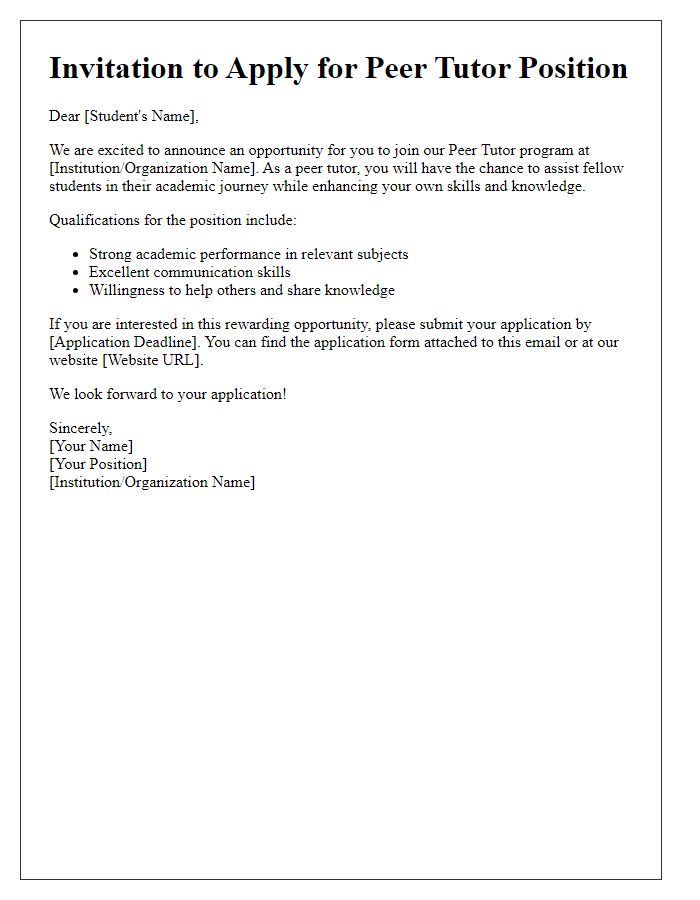Are you looking to make a positive impact in your community while enhancing your own learning experience? Our peer tutoring program is set to launch, and it's the perfect opportunity for students to both give and receive support in their studies. By participating, you'll not only strengthen your academic skills but also build meaningful friendships along the way. Join us as we explore the details of this exciting initiative and discover how you can get involved!

Clear Program Objectives
The peer tutoring program aims to enhance academic performance while fostering a collaborative learning environment for students. Key objectives include improving understanding of subject matter through personalized assistance, boosting confidence in academic abilities, and developing critical thinking skills. Each tutoring session targets specific curriculum standards, such as mathematics or language arts, measured by individual progress assessments. The program encourages students to engage actively in their learning journeys, promoting teamwork and communication skills essential for future educational endeavors. Additionally, participating tutors gain valuable leadership experience and reinforce their own knowledge, creating a mutually beneficial relationship that supports academic excellence across the school community.
Tutor and Tutee Guidelines
The Peer Tutoring Program at Riverside High School aims to foster an academic support system that promotes collaborative learning. Tutors, trained seniors with a minimum GPA of 3.5, will provide individual academic assistance to their peers in subjects such as Mathematics, Science, and English. Tutees, students seeking help, are encouraged to bring specific questions or topics they find challenging during their sessions. Each tutoring session will last for 30 minutes and take place in designated study rooms within the library. To enhance the effectiveness of the program, both tutors and tutees are advised to set clear goals for their sessions and provide feedback after each meeting. Attendance tracking will ensure accountability while rewarding active participants with community service hours. The program operates every Tuesday and Thursday from 3 PM to 5 PM, starting on November 7, 2023.
Scheduling and Availability
Peer tutoring programs require careful scheduling to accommodate diverse availability among participants. Typically, students have varying class schedules, extracurricular activities, and personal commitments that influence their free hours. Effective communication tools, like Google Calendar or Doodle polls, can help identify overlapping time frames for tutoring sessions. Sessions might take place in designated study areas, such as libraries or student lounges, promoting a conducive learning environment. A recommended frequency for meetings can be once or twice a week, ensuring consistent support without overwhelming participants. Additional considerations include time zones for remote learners and the need for flexibility in case of sudden changes in schedules.
Communication Methods
Effective communication methods are essential for the success of peer tutoring programs, fostering collaboration between students and tutors. Face-to-face meetings allow for immediate feedback and clarification of concepts, enhancing learning outcomes. Online platforms, such as Google Meet or Zoom, offer flexibility for remote sessions, accommodating different schedules and locations. Utilizing messaging applications like WhatsApp or Slack facilitates quick questions and ongoing support outside scheduled sessions, promoting continuous engagement. Additionally, shared documents on Google Drive enable real-time collaboration on assignments and resources, supporting collective problem-solving while tracking progress. Regular check-ins through email ensure that both tutors and students stay aligned with learning goals and address any challenges that may arise.
Feedback and Evaluation Process
The feedback and evaluation process in a peer tutoring program is essential for ensuring effective learning experiences among participants. Regular assessments will be conducted through anonymous surveys distributed to all involved students and tutors, evaluating the program's effectiveness and areas for improvement. These surveys will focus on specific factors like tutor preparedness, quality of instructional materials, and overall satisfaction with the tutoring sessions. Additionally, progress tracking using specific academic benchmarks will help quantify student improvements in subjects like Mathematics or Science, often measured through pre- and post-assessment scores. Scheduled feedback meetings will also provide an opportunity for open dialogue, where tutors and students can discuss experiences, challenges, and successes, contributing to a culture of continuous improvement. Overall, this ongoing evaluation process aims to enhance the learning experience and achieve the educational objectives set for the program.













Comments